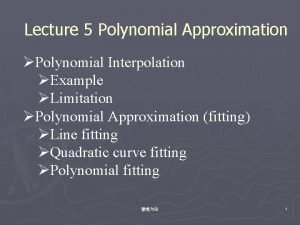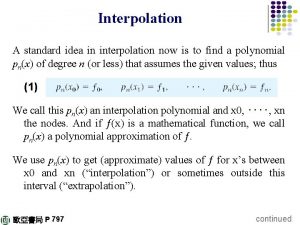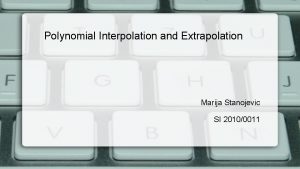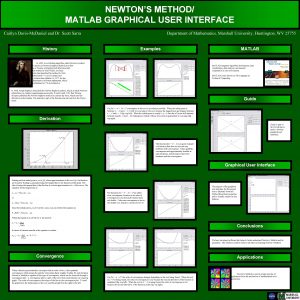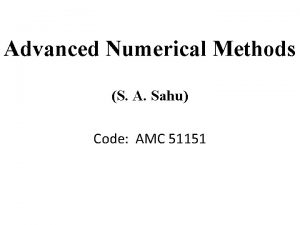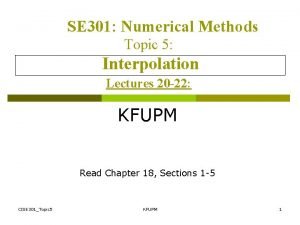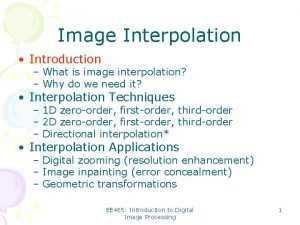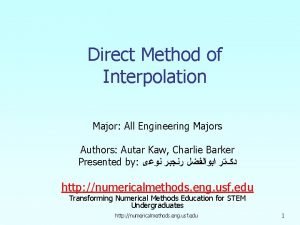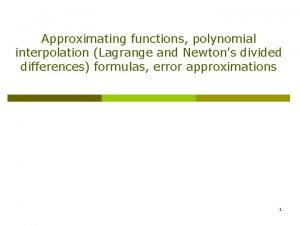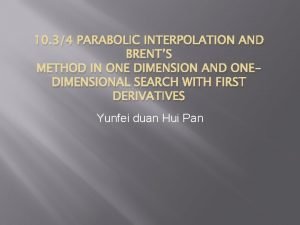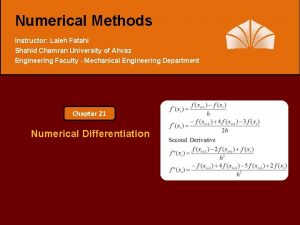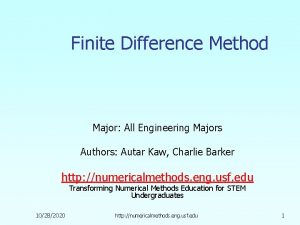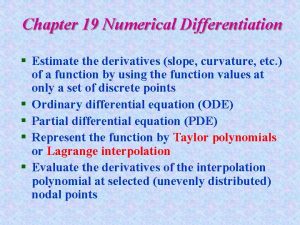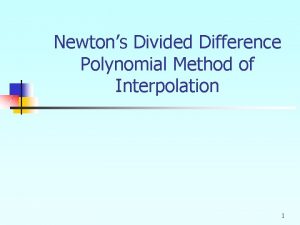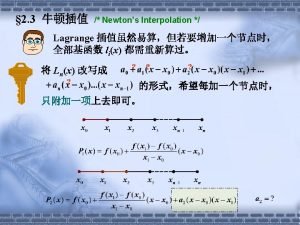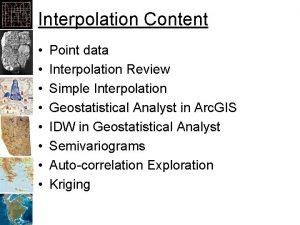Newtons Divided Difference Polynomial Method of Interpolation Chemical






















- Slides: 22

Newton’s Divided Difference Polynomial Method of Interpolation Chemical Engineering Majors Authors: Autar Kaw, Jai Paul http: //numericalmethods. eng. usf. edu Transforming Numerical Methods Education for STEM Undergraduates http: //numericalmethods. eng. usf. edu 1

Newton’s Divided Difference Method of Interpolation http: //numericalmethods. eng. usf. edu

What is Interpolation ? Given (x 0, y 0), (x 1, y 1), …… (xn, yn), find the value of ‘y’ at a value of ‘x’ that is not given. 3 lmethods. eng. usf. edu http: //numerica

Interpolants Polynomials are the most common choice of interpolants because they are easy to: Evaluate Differentiate, and Integrate. 4 lmethods. eng. usf. edu http: //numerica

Newton’s Divided Difference Method Linear interpolation: Given linear interpolant through the data pass a where 5 lmethods. eng. usf. edu http: //numerica

Example To find how much heat is required to bring a kettle of water to its boiling point, you are asked to calculate the specific heat of water at 61 °C. The specific heat of water is given as a function of time in Table 1. Use Newton’s divided difference method with a first order and then a second order polynomial to determine the value of the specific heat at T = 61°C. Table 1 Specific heat of water as a function of temperature. 6 Temperature, Specific heat, 22 42 52 82 100 4181 4179 4186 4199 4217 Figure 2 Specific heat of water vs. temperature. http: //numerica lmethods. eng. usf. edu

Linear Interpolation 7 lmethods. eng. usf. edu http: //numerica

Linear Interpolation (contd) 8 lmethods. eng. usf. edu http: //numerica

Quadratic Interpolation 9 lmethods. eng. usf. edu http: //numerica

Quadratic Interpolation (contd) 10 lmethods. eng. usf. edu http: //numerica

Quadratic Interpolation (contd) 11 lmethods. eng. usf. edu http: //numerica

Quadratic Interpolation (contd) 12 lmethods. eng. usf. edu http: //numerica

General Form where Rewriting 13 lmethods. eng. usf. edu http: //numerica

General Form 14 lmethods. eng. usf. edu http: //numerica

General form 15 lmethods. eng. usf. edu http: //numerica

Example To find how much heat is required to bring a kettle of water to its boiling point, you are asked to calculate the specific heat of water at 61 °C. The specific heat of water is given as a function of time in Table 1. Use Newton’s divided difference method with a third order polynomial to determine the value of the specific heat at T = 61°C. Table 1 Specific heat of water as a function of temperature. 16 Temperature, Specific heat, 22 42 52 82 100 4181 4179 4186 4199 4217 Figure 2 Specific heat of water vs. temperature. http: //numerica lmethods. eng. usf. edu

Example 17 lmethods. eng. usf. edu http: //numerica

Example 18 lmethods. eng. usf. edu http: //numerica

Example 19 lmethods. eng. usf. edu http: //numerica

Comparison Table 20 lmethods. eng. usf. edu http: //numerica

Additional Resources For all resources on this topic such as digital audiovisual lectures, primers, textbook chapters, multiple-choice tests, worksheets in MATLAB, MATHEMATICA, Math. Cad and MAPLE, blogs, related physical problems, please visit http: //numericalmethods. eng. usf. edu/topics/newton_div ided_difference_method. html

THE END http: //numericalmethods. eng. usf. edu
 Spline interpolation vs polynomial interpolation
Spline interpolation vs polynomial interpolation 5400x9
5400x9 Newton forward interpolation formula
Newton forward interpolation formula Neville algorithm
Neville algorithm Polynomial interpolation
Polynomial interpolation Numpy.polynomial.polynomial
Numpy.polynomial.polynomial How to divide a polynomial by another polynomial
How to divide a polynomial by another polynomial Newton's method matlab
Newton's method matlab Newton central difference interpolation formula
Newton central difference interpolation formula Gauss backward interpolation formula
Gauss backward interpolation formula Linear extrapolation example
Linear extrapolation example Direct method of interpolation
Direct method of interpolation Linear interpolation formula
Linear interpolation formula Direct method of interpolation
Direct method of interpolation Direct method interpolation
Direct method interpolation Interpolation formula
Interpolation formula Interpolation method example
Interpolation method example Parabolic interpolation formula
Parabolic interpolation formula Finite divided difference
Finite divided difference Finite divided difference
Finite divided difference Derivatives of unequally spaced data
Derivatives of unequally spaced data Bulk granules
Bulk granules Powders in pharmaceutics
Powders in pharmaceutics
